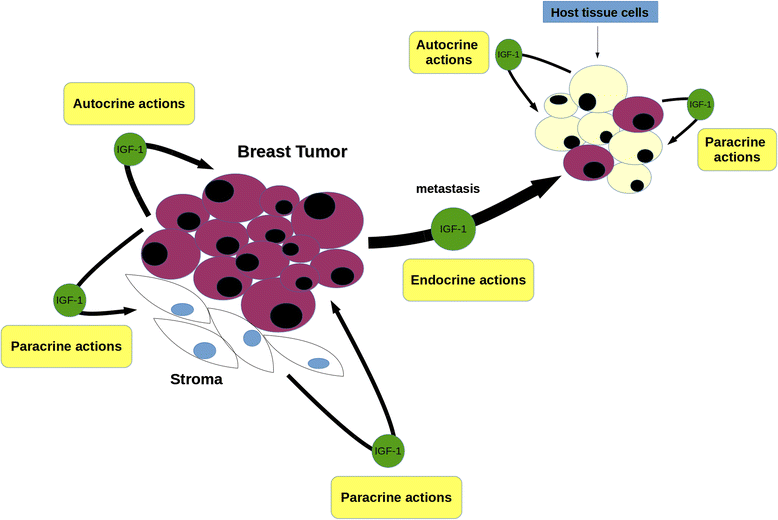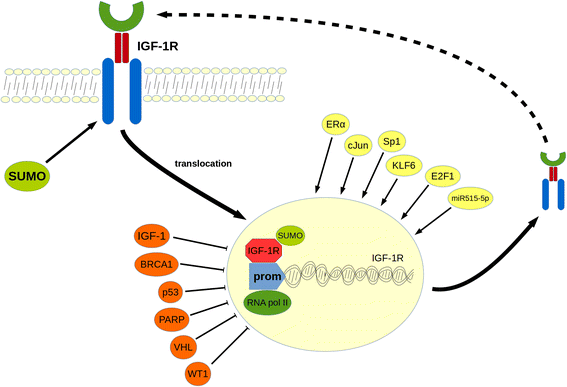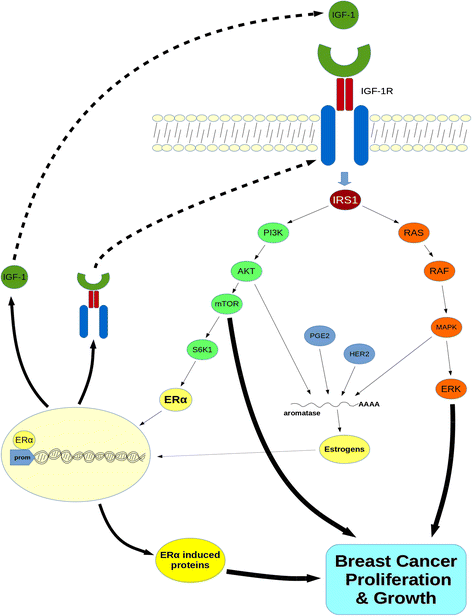The role of the insulin-like growth factor-1 system in breast cancer
- PMID: 25743390
- PMCID: PMC4335664
- DOI: 10.1186/s12943-015-0291-7
The role of the insulin-like growth factor-1 system in breast cancer
Abstract
IGF-1 is a potent mitogen of major importance in the mammary gland. IGF-1 binding to the cognate receptor, IGF-1R, triggers a signaling cascade leading to proliferative and anti-apoptotic events. Although many of the relevant molecular pathways and intracellular cascades remain to be elucidated, a growing body of evidence points to the important role of the IGF-1 system in breast cancer development, progression and metastasis. IGF-1 is a point of convergence for major signaling pathways implicated in breast cancer growth. In this review, we provide an overview and concise update on the function and regulation of IGF-1 as well as the role it plays in breast malignancies.
Figures



Similar articles
-
Interaction between estrogen receptor alpha and insulin/IGF signaling in breast cancer.Curr Cancer Drug Targets. 2008 Nov;8(7):597-610. doi: 10.2174/156800908786241104. Curr Cancer Drug Targets. 2008. PMID: 18991569 Review.
-
Molecular regulation of phenolic compounds on IGF-1 signaling cascade in breast cancer.Food Funct. 2022 Mar 21;13(6):3170-3184. doi: 10.1039/d1fo03283f. Food Funct. 2022. PMID: 35253808 Review.
-
Insulin-like growth factor - oestradiol crosstalk and mammary gland tumourigenesis.Biochim Biophys Acta. 2013 Dec;1836(2):345-53. doi: 10.1016/j.bbcan.2013.10.005. Epub 2013 Nov 2. Biochim Biophys Acta. 2013. PMID: 24189571 Review.
-
Inhibition of insulin-like growth factor signaling pathways in mammary gland by pure antiestrogen ICI 182,780.Clin Cancer Res. 2001 Aug;7(8):2545-54. Clin Cancer Res. 2001. PMID: 11489838
-
Role of the insulin-like growth factor system on an estrogen-dependent cancer phenotype in the MCF-7 human breast cancer cell line.J Steroid Biochem Mol Biol. 2008 Mar;109(1-2):185-96. doi: 10.1016/j.jsbmb.2007.10.006. Epub 2008 Feb 8. J Steroid Biochem Mol Biol. 2008. PMID: 18337089
Cited by
-
Associations Between Circulating Insulin-Like Growth Factor 1 and Mortality in Women With Invasive Breast Cancer.Front Oncol. 2020 Aug 19;10:1384. doi: 10.3389/fonc.2020.01384. eCollection 2020. Front Oncol. 2020. PMID: 32974138 Free PMC article.
-
Let-7a inhibits migration of melanoma cells via down-regulation of HMGA2 expression.Am J Transl Res. 2016 Sep 15;8(9):3656-3665. eCollection 2016. Am J Transl Res. 2016. PMID: 27725848 Free PMC article.
-
Insulin-like growth factor (IGF) levels in pre-treatment plasma identifying breast cancer: A case control study.Caspian J Intern Med. 2024 Sep 7;15(4):706-712. doi: 10.22088/cjim.15.4.706. eCollection 2024 Fall. Caspian J Intern Med. 2024. PMID: 39359441 Free PMC article.
-
The insulin-like growth factor-I receptor (IGF-IR) in breast cancer: biology and treatment strategies.Tumour Biol. 2016 Sep;37(9):11711-11721. doi: 10.1007/s13277-016-5176-x. Epub 2016 Jul 21. Tumour Biol. 2016. PMID: 27444280 Review.
-
Insulin Resistance: The Increased Risk of Cancers.Curr Oncol. 2024 Feb 13;31(2):998-1027. doi: 10.3390/curroncol31020075. Curr Oncol. 2024. PMID: 38392069 Free PMC article. Review.
References
-
- Ruan W, Kleinberg DL. Insulin-like growth factor I is essential for terminal end bud formation and ductal morphogenesis during mammary development. Endocrinology. 1999;140:5075–81. - PubMed
-
- Deeks S, Richards J, Nandi S. Maintenance of normal rat mammary epithelial cells by insulin and insulin-like growth factor 1. Exp Cell Res. 1988;174:448–60. - PubMed
Publication types
MeSH terms
Substances
LinkOut - more resources
Full Text Sources
Other Literature Sources
Medical
Miscellaneous

